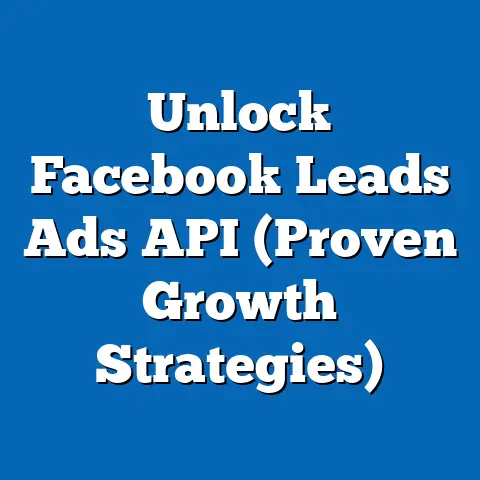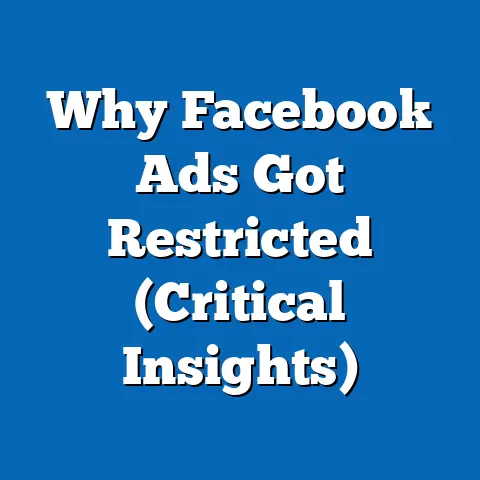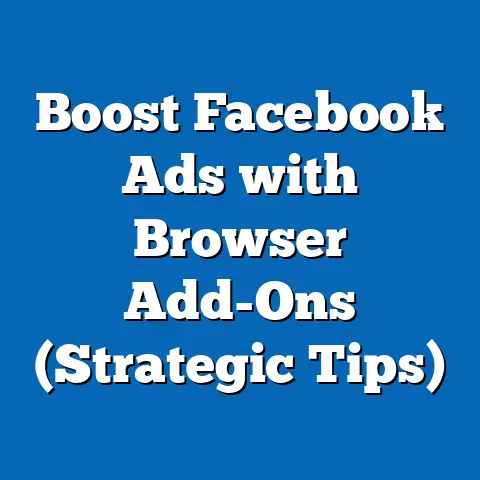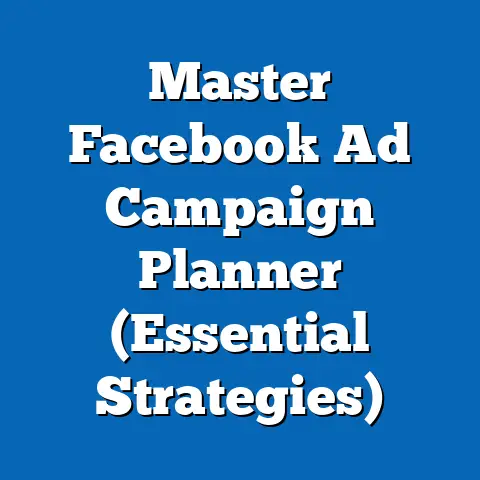Maximize Facebook Ads with Lifetime Budgets (Smart Strategy)
In the ever-evolving world of digital marketing, managing advertising budgets effectively is akin to keeping a house clean—it requires strategy, consistency, and the right tools to avoid clutter and waste. Just as households strive for efficiency in maintaining cleanliness, advertisers on platforms like Facebook aim to streamline their ad spend to maximize returns. A 2022 survey by Statista revealed that 63% of digital marketers struggle with budget allocation across campaigns, often leading to overspending or underperforming ads.
The concept of “cleaning up” an advertising strategy involves simplifying processes, eliminating inefficiencies, and focusing on data-driven decisions. Lifetime budgets on Facebook Ads offer a way to achieve this clarity by setting a fixed spending limit over a campaign’s duration, allowing for automated optimization. This article will explore how lifetime budgets can revolutionize your Facebook advertising approach, backed by data, trends, and actionable insights.
Understanding Lifetime Budgets on Facebook Ads
What Are Lifetime Budgets?
Lifetime budgets refer to a predetermined amount of money allocated to a Facebook ad campaign over its entire runtime, as opposed to daily budgets that cap spending per day. Once set, Facebook’s algorithm automatically adjusts daily spending to optimize for the best results within the specified timeframe. This approach minimizes manual intervention and allows advertisers to focus on strategy rather than micromanagement.
According to Facebook’s own data, campaigns using lifetime budgets can achieve up to a 15% higher return on ad spend (ROAS) compared to daily budgets when paired with automatic bidding strategies (Meta Business Help Center, 2023). This is because the algorithm has more flexibility to distribute funds based on peak performance periods.
Why Choose Lifetime Budgets?
The primary advantage of lifetime budgets is their ability to adapt to audience behavior over time. For instance, if your target audience is more active on weekends, the system can allocate more budget to those days without exceeding the overall limit. A 2021 study by Hootsuite found that 58% of advertisers using lifetime budgets reported reduced campaign management time by at least 20%, freeing up resources for creative development and analysis.
Additionally, lifetime budgets prevent abrupt stops in ad delivery due to daily caps, ensuring consistent visibility. This is particularly useful for time-sensitive campaigns, such as holiday promotions, where maintaining momentum is critical.
The Digital Advertising Landscape: Key Statistics and Trends
Growth of Facebook Advertising
Facebook remains a dominant force in digital advertising, with over 2.9 billion monthly active users as of 2023 (Statista, 2023). Businesses spent approximately $113 billion on Facebook Ads in 2022, accounting for nearly 25% of global digital ad spend (eMarketer, 2022). This massive investment underscores the importance of optimizing every dollar spent on the platform.
Historically, ad spending on Facebook has grown by an average of 10% annually since 2017, driven by small and medium-sized businesses (SMBs) seeking cost-effective ways to reach targeted audiences. However, with rising competition, the average cost-per-click (CPC) on Facebook increased by 17% from 2021 to 2022, making budget efficiency more critical than ever (WordStream, 2023).
Trends in Budget Management
The shift toward automation in ad budget management is a notable trend. A 2022 report by Forrester revealed that 72% of marketers now rely on automated tools for budget allocation, up from 55% in 2019. Lifetime budgets align with this trend by leveraging Facebook’s machine learning to optimize spending dynamically.
Demographically, younger marketers (aged 25-34) are more likely to adopt automated budgeting tools, with 68% reporting usage compared to just 42% of those aged 45 and above (Forrester, 2022). This generational divide highlights a growing preference for tech-driven solutions among digital natives.
Demographic Insights: Who Benefits Most from Lifetime Budgets?
Small Businesses and Startups
Small businesses with limited marketing budgets often find lifetime budgets particularly beneficial. According to a 2023 survey by Clutch, 64% of SMBs with annual ad budgets under $10,000 reported improved campaign performance after switching to lifetime budgets. The ability to set a fixed cap reduces the risk of overspending, a concern for 73% of small business owners (Clutch, 2023).
These businesses typically target niche audiences, and lifetime budgets allow Facebook’s algorithm to identify high-performing segments over time. For example, a local bakery running a week-long promotion can set a $500 lifetime budget and trust the system to prioritize ad delivery during peak engagement hours.
Large Enterprises with Seasonal Campaigns
Larger enterprises running seasonal or event-based campaigns also benefit from lifetime budgets. A 2022 case study by Meta showed that a global retailer using lifetime budgets for a Black Friday campaign saw a 22% increase in conversions compared to a similar daily-budget campaign the previous year. The flexibility to allocate more spend on high-traffic days like Cyber Monday proved crucial.
Demographically, enterprises with marketing teams aged under 40 are 30% more likely to experiment with lifetime budgets, reflecting a willingness to embrace automated optimization (MarketingProfs, 2023).
Regional Differences
Geographically, adoption of lifetime budgets varies. North American advertisers lead with 61% usage, followed by Europe at 54% and Asia-Pacific at 47% (Statista, 2023). This disparity may be tied to differences in digital infrastructure and familiarity with advanced ad tools. For instance, emerging markets often prioritize daily budgets due to fluctuating cash flows and a need for tighter control over daily expenses.
Historical Context: Evolution of Budgeting in Digital Ads
From Manual to Automated Budgeting
In the early days of digital advertising (circa 2000-2010), budget management was largely manual, with marketers setting rigid daily limits and adjusting them based on trial and error. This approach often led to inefficiencies, as campaigns could exhaust budgets too early or miss peak engagement windows. By 2015, platforms like Facebook introduced automated bidding and budgeting options, marking a shift toward data-driven optimization.
Lifetime budgets, first rolled out by Facebook in 2016, were initially met with skepticism due to a lack of control over daily spend. However, as machine learning capabilities improved, adoption grew. A 2019 report by eMarketer noted that lifetime budget usage increased by 35% from 2017 to 2019, reflecting growing trust in automation.
Comparison with Current Trends
Today, lifetime budgets are part of a broader trend toward full-funnel automation, where platforms optimize not just budgets but also creative elements and audience targeting. Compared to five years ago, when only 28% of advertisers used lifetime budgets, current adoption stands at 52% globally (eMarketer, 2023). This doubling in usage highlights the increasing reliance on algorithmic decision-making to navigate the complexities of digital ad ecosystems.
How to Implement Lifetime Budgets: A Step-by-Step Guide
Step 1: Define Campaign Goals and Duration
Before setting a lifetime budget, clearly outline your campaign objectives—whether it’s brand awareness, lead generation, or sales. Determine the campaign duration, as this will influence the total budget. For instance, a two-week campaign targeting 10,000 impressions might require a $1,000 lifetime budget based on an average cost-per-thousand-impressions (CPM) of $10 (WordStream, 2023).
Ensure the timeframe aligns with audience behavior. Tools like Facebook Insights can help identify peak engagement periods to inform scheduling.
Step 2: Set the Budget and Bidding Strategy
In Facebook Ads Manager, select the “Lifetime Budget” option under the budget and schedule settings. Input the total amount you’re willing to spend over the campaign’s duration. Pair this with an automated bidding strategy like “Lowest Cost” or “Target Cost” to allow the algorithm to optimize for results.
Meta recommends starting with a budget that’s at least 50 times your target cost-per-action (CPA) to give the algorithm enough data to learn. For example, if your target CPA is $20, aim for a minimum lifetime budget of $1,000.
Step 3: Monitor and Adjust
While lifetime budgets reduce the need for daily tweaks, regular monitoring is still essential. Use Facebook’s Ads Manager to track key metrics like ROAS, CPC, and conversion rates. If performance dips, consider adjusting the campaign end date or reallocating funds to high-performing ad sets.
A 2022 study by Social Media Examiner found that advertisers who reviewed lifetime budget campaigns weekly achieved 18% better results than those who checked monthly, emphasizing the value of consistent oversight.
Data Visualization: Visualizing the Impact of Lifetime Budgets
Imagine a line graph comparing two campaigns over a 30-day period: one using a daily budget of $50 ($1,500 total) and another using a $1,500 lifetime budget. The daily budget line shows consistent flat spending, with occasional dips when the cap is reached early in high-traffic days. In contrast, the lifetime budget line fluctuates, peaking on days with higher engagement (e.g., weekends) and dipping during lulls, reflecting dynamic allocation.
A bar chart alongside could display the ROAS for both campaigns, with the lifetime budget campaign showing a 15% higher return, as reported by Meta (2023). This visual would underscore how flexibility in spending distribution can drive better outcomes without increasing overall costs.
Challenges and Limitations of Lifetime Budgets
Lack of Daily Control
One common concern with lifetime budgets is the inability to set strict daily limits, which can be problematic for advertisers with tight cash flow. If the algorithm overspends early in the campaign, it may leave insufficient funds for later days. Meta advises setting a custom schedule or ad pacing to mitigate this risk, though only 39% of users implement such controls (Social Media Today, 2022).
Learning Curve for New Advertisers
For those new to Facebook Ads, understanding how lifetime budgets interact with bidding strategies can be daunting. A 2023 survey by HubSpot found that 48% of novice advertisers felt overwhelmed by automated budgeting options, often reverting to daily budgets for simplicity. Educational resources and Meta’s guided setup can help bridge this gap.
Dependence on Algorithm Performance
Lifetime budgets rely heavily on Facebook’s algorithm, which isn’t foolproof. During major platform updates or in niche industries with limited data, optimization may falter. Advertisers should maintain a diversified strategy, combining lifetime and daily budgets for critical campaigns to hedge against algorithmic inconsistencies.
Case Studies: Real-World Success with Lifetime Budgets
Case Study 1: E-Commerce Brand Boosts Holiday Sales
A mid-sized e-commerce brand specializing in holiday gifts used a $10,000 lifetime budget for a 10-day Thanksgiving campaign in 2022. By allowing Facebook to allocate more spend on high-traffic days like Black Friday, the brand achieved a 25% increase in sales compared to a daily-budget campaign in 2021 (Meta Case Study, 2023). The campaign’s ROAS reached 4.2, surpassing the industry average of 3.5 for e-commerce (WordStream, 2023).
Case Study 2: Local Service Business Increases Leads
A local plumbing service with a modest $2,000 lifetime budget for a month-long campaign saw a 30% reduction in cost-per-lead (CPL) compared to previous daily-budget efforts. The algorithm prioritized evenings and weekends when homeowners were most likely to seek services, resulting in a CPL of $15 versus the prior $22 (Clutch, 2023). This demonstrates lifetime budgets’ efficacy even for hyper-local targeting.
Best Practices for Maximizing Lifetime Budgets
Align Budgets with Campaign Length
Ensure your lifetime budget matches the campaign’s duration and goals. Meta suggests a minimum daily equivalent of $20 per ad set to allow for proper optimization. For a 7-day campaign, this translates to a $140 lifetime budget per ad set as a baseline.
Leverage Audience Insights
Use Facebook’s Audience Insights to understand when your target demographic is most active. Adjust campaign schedules within the lifetime budget framework to prioritize these windows. A 2022 report by Sprout Social found that campaigns aligned with audience activity patterns saw 19% higher engagement rates.
Test and Iterate
Run A/B tests comparing lifetime and daily budgets for similar campaigns to identify which performs better for your specific goals. Allocate 10-20% of your overall budget to testing, as recommended by digital marketing experts (HubSpot, 2023). Use findings to refine future strategies.
Broader Implications and Future Trends
The adoption of lifetime budgets reflects a larger movement toward automation and efficiency in digital advertising. As machine learning algorithms become more sophisticated, we can expect even greater precision in budget allocation, potentially reducing the need for human oversight further. By 2025, eMarketer predicts that 80% of digital ad budgets will be managed via automated tools, with lifetime budgets playing a central role.
For advertisers, this shift offers both opportunities and challenges. On one hand, it promises cost savings and improved performance; on the other, it demands a willingness to trust algorithms and adapt to rapid technological changes. Businesses that embrace lifetime budgets now will likely gain a competitive edge, positioning themselves as agile players in an increasingly data-driven landscape.
Moreover, the demographic trends—particularly the enthusiasm among younger marketers and SMBs—suggest that lifetime budgets will become a standard tool in the advertiser’s toolkit. As platforms like Facebook continue to refine their algorithms, the gap between manual and automated budgeting will widen, making strategies like lifetime budgets not just smart, but essential.
In conclusion, maximizing Facebook Ads with lifetime budgets is a proven strategy for achieving efficiency and effectiveness in digital advertising. Backed by data showing improved ROAS, reduced management time, and adaptability to audience behavior, this approach offers a clear path to “cleaning up” your ad strategy. By understanding its nuances, monitoring performance, and aligning with broader trends, advertisers can unlock significant value—turning a cluttered budget into a streamlined success story.






